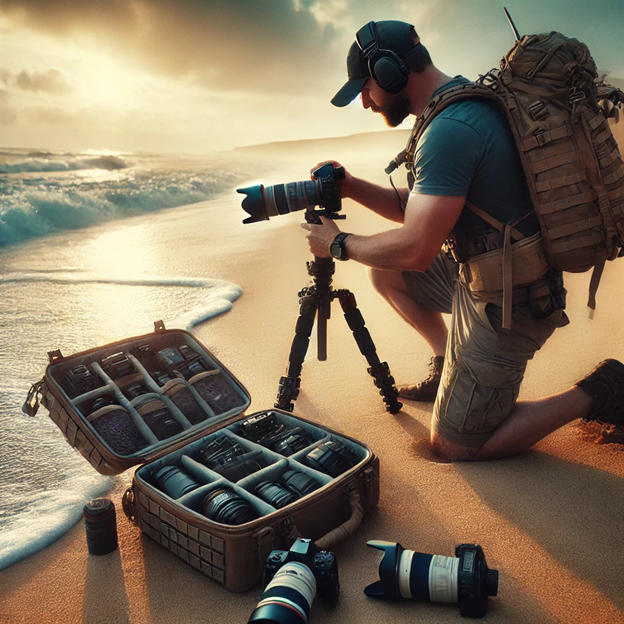Beach photography offers a unique blend of challenges and opportunities. The ever-changing light, the expansive scenery, and the dynamic interactions between water, sand, and sky make for stunning photographic possibilities. Whether you’re capturing landscapes, family portraits, or weddings, being a great beach photographer requires not just technical skill, but also the right equipment and preparation. This article explores what it takes to excel in beach photography, with a special focus on wedding photography, the importance of having a versatile tactical backpack, and the essential gear that will help you succeed.
Beach photography is all about capturing the essence of the sea, sand, and sky. To truly master this art, you need to understand how to work with natural light, deal with reflections, and use the environment to your advantage. The key is to embrace the natural elements rather than fight against them.
National Geographic highlights that the golden hour, just after sunrise or before sunset, is the most popular time for professional photographers due to the warm, soft light that enhances the natural beauty of the beach.
Beach weddings are a popular choice for couples looking for a romantic and picturesque setting. However, capturing the perfect moments at a beach wedding presents its own set of challenges. From dealing with unpredictable weather to ensuring that the couple looks their best against the bright backdrop of the sea, a beach wedding photographer must be skilled, adaptable, and well-prepared to ensure the wedding photo album is on point.
WeddingWire reports that 20% of all weddings in the U.S. are destination weddings, with beach locations being among the most popular, highlighting the demand for skilled beach wedding photographers.
One of the most challenging aspects of beach photography is dealing with the ever-changing conditions. Weather at the beach can shift rapidly, from bright sunlight to overcast skies, or even sudden rain showers. Understanding how to adapt to these changes is crucial for capturing the best possible images. For instance, while clear skies might be ideal for vibrant landscape shots, an overcast day can provide soft, even lighting that’s perfect for portraits, reducing harsh shadows and highlights. Always have a plan B, whether it’s finding sheltered spots for shooting during rain or using reflectors and diffusers to manage lighting in bright conditions. Flexibility and quick thinking are your best assets when working in such a dynamic environment.
Additionally, consider the tides and their impact on your shooting locations. High tide might limit your access to certain parts of the beach, while low tide can reveal interesting features like tide pools or rock formations that make for compelling compositions. By being aware of the tide schedule, you can plan your shoots to take advantage of these natural changes, ensuring that you capture the most dynamic and unique images.
To truly establish yourself as a great beach photographer, it’s essential to build a portfolio that showcases your versatility and expertise. Your portfolio should include a mix of different types of beach photography—landscapes, portraits, and event photography like weddings—to demonstrate your ability to handle a variety of scenarios. Highlight your best work that captures the essence of beach life, from the serene beauty of a sunrise over the ocean to the joyful energy of a beach wedding.
When selecting images for your portfolio, focus on those that tell a story and evoke emotion. Potential clients, especially those looking for wedding photography, are often drawn to photographers whose work conveys a narrative and captures meaningful moments. Additionally, consider presenting your work in both digital and physical formats, such as high-quality photo books, which can be particularly effective in client meetings or at photography exhibits. A strong, diverse portfolio not only attracts clients but also sets you apart in a competitive market, establishing you as a go-to photographer for all things beach-related.
Being a beach photographer often means carrying a variety of equipment to adapt to different conditions and capture the best shots. A tactical backpack is an invaluable asset, providing the versatility and durability needed to safely transport your gear in challenging environments.
Feature | Description | Benefit |
Versatile Storage | Multiple compartments and customizable dividers | Efficient organization and quick access to gear |
Durability and Protection | Rugged, water-resistant materials | Protects gear from sand, water, and sun exposure |
Comfort and Support | Padded straps and ergonomic design | Reduces physical strain, allowing for longer shoots |
Accessibility | Side or front access panels | Enables quick access to equipment during shoots |
Outdoor Photographer notes that having the right backpack can make a significant difference in a photographer’s ability to work efficiently in outdoor environments, emphasizing the importance of investing in quality gear.
While having the right techniques and a tactical backpack is crucial, the quality of your photography will ultimately depend on the equipment you bring. The beach environment presents specific challenges, and having the right gear can help you capture stunning images while protecting your investment.
B&H Photo Video highlights that 65% of professional photographers carry multiple lenses and filters to adapt to different conditions, underscoring the importance of being well-equipped for various scenarios.
Becoming a great beach photographer requires a combination of technical skill, creative vision, and the right equipment. Whether you’re capturing the beauty of the natural landscape or the joy of a beach wedding, understanding how to work with the unique challenges of the beach environment is key to producing stunning images. Investing in a good tactical backpack will not only help you carry your gear comfortably but also protect it from the harsh conditions often encountered at the beach. With the right preparation and tools, you can elevate your beach photography and create images that resonate with your clients and audience.